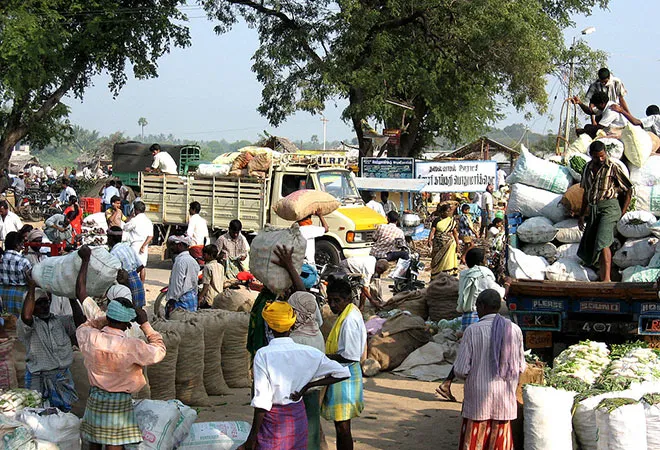-
CENTRES
Progammes & Centres
Location

The rural economy is in deep trouble today, even according to the Finance Minister, and hence will hopefully get adequate attention in the Budget 2018 because more than 50 percent of the population is dependent on agriculture and 70 per cent of the population lives in the country side.
Lack of jobs in the rural economy, low productivity and low profit realisation are pushing people out of agriculture and parents don’t want their daughters married to farmers. Farmers still continue to commit suicide in different parts of India.
Prime Minister Modi has promised to double farm incomes by 2022. This is not an impossible task considering that farming households are earning only around Rs 6,436 per month (according to the National Sample Survey in 2012-13), equivalent to a dinner for two in a five star hotel of Delhi. The rural urban divide is causing a huge exodus from rural to urban areas.
Many economists think it is a good idea to move people from agriculture to industry as it will encourage urbanisation. In US, only around 2 per cent and in EU, around 5 per cent of the population is dependent on agriculture. Yet farm productivity is very high due to mechanisation. The developed countries also heavily subsidise farmers in order to keep producer prices low and dump their produce in developing countries, regularly causing price distortions. In this heavily subsidised, highly mechanised world of modern agriculture, how can India bring about a turnaround?
As agriculture is a State subject, many of the much needed reforms are in the hands of State governments but major irrigation works for improving the access to water resources in the rural areas are under the central government. Other infrastructural projects like building roads and railways, important for rural development are also with the Centre. Hence first and foremost public investment in agriculture has to go up a proportion of the total expenditure in Budget 2018.
But how can small and marginal farmers increase productivity on tiny parcels of land, especially when they are tenant farmers? This question has been addressed in the proposed Model Agricultural Land Leasing Act which will lead to security of tenure and could lead to consolidation of operational landholdings. Tenants will have access to institutional credit if the land leased is legalised. It will incentivise tenants to make investment in land improvement, but this Act has not been adopted by States.
Access to better seeds, fertilizer, irrigation and credit have been addressed in the Action plan of Niti Ayog.
The digitalisation of agricultural trading, however, will have to wait for deeper internet penetration in rural areas and a rise in computer literacy among farmers to reap the full benefits.
It will help farmers become aware of crop prices in the next season in order to judiciously plant their crops. Access to vital market information could be provided by the National Agriculture Market portal.
Marketing reforms have been undertaken only by 20 States. To avoid exploitation, the APMC Act made it compulsory for farmers to take the produce to mandis, but the regulations proved too difficult for farmers and were misused, subjecting farmers to exploitation by middlemen who in many cases became their moneylenders. If farmers could sell to private parties at their door step, their problems would be solved to a great extent. But one needs to protect farmers from corporate buyers dictating prices. Better storage and transportation are also important for higher returns to farmers.
Rural industrialisation for raising rural livelihood is not being talked about much, but it is important to have proper infrastructure in place to initiate it. Only then, the private sector will come to invest. Rural non-farm job creation should be an important focus of the government because jobs in the manufacturing sector are not growing fast enough. The service industry in villages can be geared towards people interested in rural tourism. There are hardly any good hotels in rural India where people can stay for a couple of days to experience rural life. Developing rural tourism is an idea that has long been adopted in Europe. It is heartening to see that Airbnb has been successfully launched in rural Gujarat and farmers are earning by keeping guests.
Remunerative returns by increasing MSP to a level which is 50 per cent above cost of production was promised by Prime Minister Narendra Modi, but this has not been implemented though there is hope that MSP will be increased and extended to more crops in the next Budget. The Niti Ayog wants to give price support only to products whose prices have fallen drastically in the future. This may help rectify the distorted cropping pattern in India.
Indebtedness and crop failures are the main causes of farmers’ suicide. Access to credit without hassles, paperwork and collaterals is still yet to materialise. As a result, the marginal famers borrow from moneylenders, and not from institutions. Hence loan waivers that are directed to bank loans are not helping small farmers.
Crop insurance has been started, but it is neither universal nor without problems and this makes most farmers still vulnerable to crop failures.
For raising productivity, mechanisation is important and renting farm machinery from a pool rather than buying it individually should be organised. Also growing of GM crops has been suggested for resistance to pests and drought by the Niti Ayog. While it is true that countries growing GM crops have been consuming them for decades and have not shown major ill side effects, it is still a controversial subject which needs scrutiny.
Private investment in contract farming and cold chains has been suggested by the government, but many lacunae remain regarding the involvement of small and marginal farmers. Development of cold storage and refrigerated transportation from farms to supermarkets will be important with India opening up its retail sector in food. But investors looking for best returns will choose States which have good infrastructure and bigger sized farms. The rural areas that are least developed will be left out and farmers will continue to languish in poverty.
If agriculture is the main focus of the government in Budget 2018, a lot can be achieved because all the problems are well-known but solutions have not been implemented adequately enough.
The views expressed above belong to the author(s). ORF research and analyses now available on Telegram! Click here to access our curated content — blogs, longforms and interviews.

Jayshree Sengupta was a Senior Fellow (Associate) with ORF's Economy and Growth Programme. Her work focuses on the Indian economy and development, regional cooperation related ...
Read More +
David Rusnok Researcher Strengthening National Climate Policy Implementation (SNAPFI) project DIW Germany
Read More +